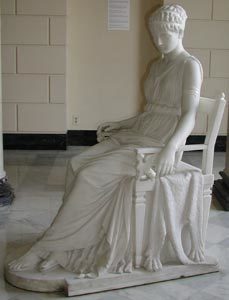The ancient Greek word νόστος (nostos) is a common theme in Greek literature that is used to describe a hero’s journey home. The most famous epic which centers around nostos is Homer’s The Odyssey, written in the 8th century BCE. The protagonist, Odysseus, undertakes a difficult twenty-year-long journey from Troy to his home in Ithaca, making difficult decisions and sacrifices along the way. In book 23, Odysseus finally lands in Ithaca and teams up with his son, Telemachus, to defeat the arrogant, gluttonous band of suitors and reassert his place as king of Ithaca.
Before truly reclaiming his throne, however, Odysseus must convince his wife, Penelope, that he has really come home. As a highly intelligent woman, she is naturally suspicious. Her husband has been gone for twenty years—time and the war would certainly have altered his appearance. She has been keeping suitors at bay for all this time; how is she to know that this strange man is not simply looking to claim her husband’s title? Penelope creates a clever ruse; she asks her maid to move her bed so that the man could rest after his battle with the suitors. As it was Odysseus who carved the bed by his own hand, Penelope determines that only the real Odysseus would know that this task could not be performed. Odysseus becomes irritated, stating that it would be impossible to move the bed as it was carved out of a tree and is rooted there. It is at this moment that Penelope knows that her husband has returned at last and rushes to embrace him.
Nostos is about the physical journey home, but it also connotes safety and the feeling of rightness—everything is as it should be. The moment that Penelope truly recognizes her husband, they both feel euphoria and epic relief; it is here, surrounded by his family and his fatherland, that Odysseus experiences the full extent of nostos and is truly home.

The marble statue of Penelope created by Franklin Simmons ca. 1891 is located in the Fleming Museum’s Marble Court. She is seated in an armchair, right hand on the arm and legs crossed at the ankles. The effigy is generally considered to be his finest effort in neoclassical marble statuary. This sculpture will act as part of the upcoming exhibition “House to Home” in the Fall of 2018. A copy of The Odyssey will remain inside the Wolcott Gallery for visitors to peruse as a link to Penelope, the concept of nostos, and the exhibit’s overarching theme.
